ATV NVR4P-2TB, NVR4P-3TB, NVR4P-4TB User Manual
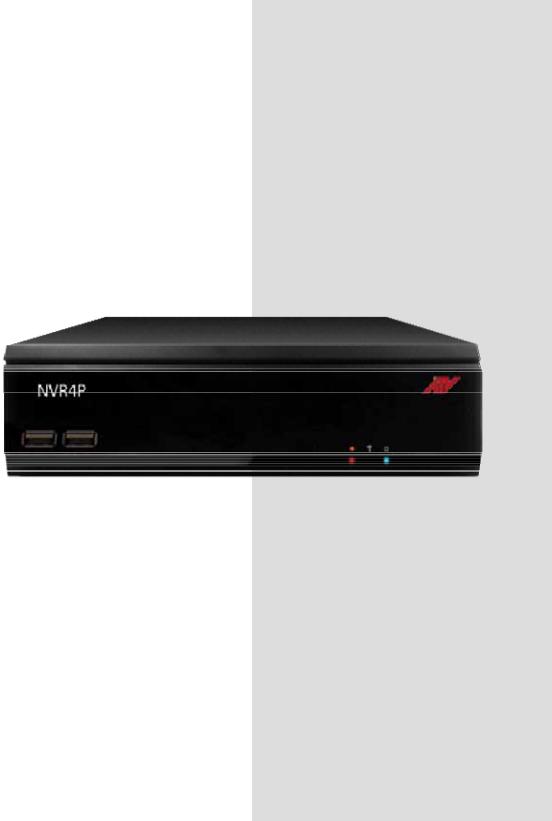
INSTRUCTION MANUAL
4 Channel (POE)
Network Video Recorder
Model : NVR4P
Please read this manual thoroughly before use, and keep it handy for future reference.

WARNING
TO REDUCE THE RISK OF FIRE OR ELECTRIC SHOCK, DO NOT EXPOSE THIS PROCUCT TO RAIN OR MOISTURE. DO NOT INSERT ANY METALLIC OBJECT THROUGH THE VENTILATION GRILLS OR OTHER OPENNINGS ON THE EQUIPMENT.
CAUTION
EXPLANATION OF GRAPHICAL SYMBOLS
The lightning flash with arrowhead symbol, within an equilateral triangle, is intended to alert the user to the presence of uninsulated "dangerous voltage" within the product’s enclosure that may be of sufficient magnitude to constitute a risk of electric shock.
The exclamation point within an equilateral triangle is intended to alert the user to the presence of important operating and maintenance (servicing) instructions in the literature accompanying the appliance.
PRECAUTIONS
Safety -------------------------------------- Installation -------------------------------
Should any liquid or solid object fall into the cabinet, unplug the unit and have it checked by the qualified personnel before operating it any further.
Unplug the unit from the wall outlet if it is not going to be used for several days or more. To disconnect the cord, pull it out by the plug. Never pull the cord itself.
Allow adequate air circulation to prevent internal heat build-up. Do not place the unit on surfaces (rugs, blankets, etc.) or near materials (curtains, draperies) that may block the ventilation holes.
Height and vertical linearity controls located at the rear panel are for special adjustments by qualified personnel only.
Do not install the unit in an extremely hot or humid place or in a place subject to excessive dust, mechanical vibration.
The unit is not designed to be waterproof. Exposure to rain or water may damage the unit.
Cleaning ---------------------------------
Clean the unit with a slightly damp soft cloth. Use a mild household detergent. Never use strong solvents such as thinner or benzene as they might damage the finish of the unit.
Retain the original carton and packing materials for safe transport of this unit in the future.
2

FCC COMPLIANCE STATEMENT
INFORMATION TO THE USER: THIS EQUIPMENT HAS BEEN TESTED AND FOUND TO COMPLY WITH THE LIMITS FOR A CLASS A DIGITAL DEVICE, PURSUANT TO PART 15 OF THE FCC RULES. THESE LIMITS ARE DESIGNED TO PROVIDE REASONABLE PROTECTION AGAINST HARMFUL INTERFERENCE WHEN THE EQUIPMENT IS OPERATED IN A COMMERCIAL ENVIRONMENT. THIS EQUIPMENT GENERATES, USES, AND CAN RADIATE RADIO FREQUENCY ENERGY AND IF NOT INSTALLED AND USED IN ACCORDANCE WITH THE INSTRUCTION MANUAL, MAY CAUSE HARMFUL INTERFERENCE TO RADIO COMMUNICATIONS.
CAUTION: CHANGES OR MODIFICATIONS NOT EXPRESSLY APPROVED BY THE PARTY RESPONSIBLE FOR COMPLIANCE COULD VOID THE USER'S AUTHORITY TO OPERATE THE EQUIPMENT.
THIS CLASS A DIGITAL APPARATUS COMPLIES WITH CANADIAN ICES-003.
CET APPAREIL NUMÉRIQUE DE LA CLASSE A EST CONFORME À LA NORME NMB-003 DU CANADA.
CE COMPLIANCE STATEMENT
WARNING: This is a Class A product. In a domestic environment this product may cause radio interference in which case the user may be required to take adequate measures.
3

IMPORTANT SAFETY INSTRUCTIONS
1.Read these instructions.
2.Keep these instructions.
3.Heed all warnings.
4.Follow all instructions.
5.Do not use this apparatus near water.
6.Clean only with dry cloth.
7.Do not block any ventilation openings. Install in accordance with the manufacturer’s instructions.
8.Do not install near any heat sources such as radiators, heat registers, stoves, or other apparatus (including amplifiers) that produce heat.
9.Do not defeat the safety purpose of the polarized or grounding-type plug. A polarized plug has two blades with one wider than the other. A grounding type plug has two blades and a third grounding prong. The wide blade or the third prong is provided for your safety. If the provided plug does not fit into your outlet, consult an electrician for replacement of the obsolete outlet.
10.Protect the power cord from being walked on or pinched particularly at plugs, convenience receptacles, and the point where they exit from the apparatus.
11.Only use attachments/accessories specified by the manufacturer.
12.Use only with the cart, stand, tripod, bracket, or table specified by the manufacturer, or sold with the apparatus. When a cart is used, use caution when moving the cart/apparatus combination to avoid injury from tip-over.
13.Unplug this apparatus during lightning storms or when unused for long periods of time.
14.Refer all servicing to qualified service personnel. Servicing is required when the apparatus has been damaged in any way, such as powersupply cord or plug is damaged, liquid has been moisture, does not operate normally, or has been dropped.
15.CAUTION – THESE SERVICING INSTRUCTIONS ARE FOR USE BY QUALIFIED SERVICE PERSONNEL ONLY. TO REDUCE THE RISK OF ELECTRIC SHOCK DO NOT PERFORM ANY SERVICING OTHER THAN THAT CONTAINED IN THE OPERATING INSTRUCTIONS UNLESS YOU ARE QUALIFIED TO DO SO.
16.Use power source that satisfies clause 2.5 of IEC60950-1/UL60950-1 or Certified/Listed Class 2.
17.ITE is to be connected only to PoE networks without routing to the outside plant.
4
Contents |
|
Chapter 1. Introduction............................................................................................................................ |
9 |
1.1. Description........................................................................................................................................ |
9 |
1.2. Components ..................................................................................................................................... |
9 |
1.3. Key Features .................................................................................................................................... |
9 |
1.4. Basic Security System Configuration .............................................................................................. |
11 |
1.5. Front Panel View ............................................................................................................................ |
12 |
1.6. Rear Panel View............................................................................................................................. |
12 |
1.7. IR Remote Control.......................................................................................................................... |
13 |
Chapter 2. Installation............................................................................................................................ |
14 |
2.1. HDD Installation.............................................................................................................................. |
14 |
2.2. Network Connection Setup............................................................................................................. |
14 |
2.2.1. Using a Static IP Address ............................................................................................................ |
14 |
2.2.2. Using a Dynamic IP Address....................................................................................................... |
15 |
2.2.3. Router Configuration ................................................................................................................... |
15 |
2.2.3.1. WAN Setting ............................................................................................................................. |
15 |
2.2.3.2. DHCP & IP Address Setting ..................................................................................................... |
16 |
2.2.3.3. Virtual Server Setting................................................................................................................ |
16 |
STARTING THE SYSTEM..................................................................................................................... |
17 |
Live Menu Description ........................................................................................................................... |
20 |
System Information................................................................................................................................ |
21 |
Live Menu navigating using the mouse ................................................................................................. |
22 |
Navigating to the different channels by using the mouse...................................................................... |
22 |
Navigating to different channels by using the remote control. .............................................................. |
23 |
Chapter 3. Main Menu Setup................................................................................................................. |
24 |
3.1. Video/Audio Setup.......................................................................................................................... |
25 |
3.1.1. Camera........................................................................................................................................ |
25 |
3.1.2. IP Camera Registration ............................................................................................................... |
26 |
3.1.3. IP Camera Setup ......................................................................................................................... |
29 |
3.1.4. Image Setup ................................................................................................................................ |
31 |
3.1.5. Monitor......................................................................................................................................... |
32 |
3.1.5. Sequence / Event Display ........................................................................................................... |
33 |
3.1.6. OSD / Display Position ................................................................................................................ |
34 |
3.1.7. Screen Mode ............................................................................................................................... |
35 |
3.2. Record Setup.................................................................................................................................. |
36 |
3.2.1. Policy ........................................................................................................................................... |
36 |
3.2.2. Record Quality............................................................................................................................. |
37 |
3.2.3. Record Method ............................................................................................................................ |
38 |
3.2.4. Record Option ............................................................................................................................. |
38 |
3.2.5. Schedule Setup ........................................................................................................................... |
39 |
3.2.6. Holiday......................................................................................................................................... |
40 |
3.2.7. Motion.......................................................................................................................................... |
41 |
3.2.8. Event Recording Duration ........................................................................................................... |
42 |
3.3. Device Setup .................................................................................................................................. |
43 |
3.3.1. Storage ........................................................................................................................................ |
43 |
3.3.2. Sensor / Video Loss Detection Setup.......................................................................................... |
46 |
3.3.3. Alarm Schedule ........................................................................................................................... |
47 |
3.3.4. PTZ.............................................................................................................................................. |
48 |
3.3.5. System Controller / Printer Device .............................................................................................. |
49 |
3.3.6. POS / ATM Device....................................................................................................................... |
49 |
3.3.7. Video Analysis ............................................................................................................................. |
50 |
5 |
|
3.4. System Setup ................................................................................................................................. |
51 |
3.4.1. Date/Time Setup.......................................................................................................................... |
51 |
3.4.2. Language / Signal / Device name ............................................................................................... |
52 |
3.4.3. Config .......................................................................................................................................... |
52 |
3.4.4. Log Information............................................................................................................................ |
53 |
3.4.5. Authorization Management.......................................................................................................... |
54 |
3.4.5.1. Admin........................................................................................................................................ |
54 |
3.4.5.2. Group........................................................................................................................................ |
55 |
3.4.5.3. User .......................................................................................................................................... |
56 |
3.4.5.4. Setup ........................................................................................................................................ |
56 |
3.5. Network Setup ................................................................................................................................ |
58 |
3.5.1. Connection .................................................................................................................................. |
58 |
3.5.2. Port / Connection Test ................................................................................................................. |
61 |
3.5.3. DVRNS / Dashboard ................................................................................................................... |
62 |
3.5.3.1. DVRNS Registration................................................................................................................. |
62 |
3.5.4. Dashboard Setup......................................................................................................................... |
63 |
3.5.4.1. Setup/Registration.................................................................................................................... |
63 |
3.5.4.2. Dashboard Starting................................................................................................................... |
64 |
3.5.4.3. Dashboard Login ...................................................................................................................... |
65 |
3.5.4.4. DVR/NVR Search..................................................................................................................... |
65 |
3.5.4.5. Remote Login ........................................................................................................................... |
66 |
3.5.5. DDNS .......................................................................................................................................... |
67 |
3.5.6. NAT Traversal.............................................................................................................................. |
68 |
3.5.7. FTP File Transfer......................................................................................................................... |
68 |
3.5.8. Email / SNS (Social Network Service)......................................................................................... |
69 |
3.5.8.1. Email /SNS: SMTP ................................................................................................................... |
69 |
3.5.8.2. Email/SNS: Event ..................................................................................................................... |
70 |
3.5.8.3. Email / SNS: Schedule ............................................................................................................. |
71 |
3.5.8.4 Email /SNS: Recipient ............................................................................................................... |
71 |
3.5.9. iSCSI ........................................................................................................................................... |
72 |
3.5.9.1. NVR iSCSI Setting.................................................................................................................... |
72 |
3.5.9.2. iSCSI device block size. ........................................................................................................... |
74 |
3.6. Backup Setup ................................................................................................................................. |
75 |
CHAPTER 4: Search Menu................................................................................................................... |
76 |
4.1. Time Search ................................................................................................................................... |
76 |
4.2. Event Search .................................................................................................................................. |
78 |
4.3. Protect ............................................................................................................................................ |
78 |
4.4. Capture........................................................................................................................................... |
79 |
4.5. POS/ATM Device............................................................................................................................ |
79 |
4.6. Video Analysis ................................................................................................................................ |
80 |
CHAPTER 5. General Operation........................................................................................................... |
81 |
5.1. General Menu................................................................................................................................. |
81 |
5.1 .1. General Menu: Screen Mode ..................................................................................................... |
83 |
Auto Sequence ...................................................................................................................................... |
83 |
PIP (Picture in Picture) .......................................................................................................................... |
84 |
5.1.2. General Menu: Audio OFF .......................................................................................................... |
84 |
5.1.3. General Menu: Zoom In .............................................................................................................. |
85 |
5.1.4. General Menu: Freeze ................................................................................................................ |
86 |
5.1.5. General Menu: Stop Alarm .......................................................................................................... |
86 |
5.1.6. General Menu: Record Start/Stop ............................................................................................... |
87 |
5.1.7. General Menu: Play..................................................................................................................... |
87 |
5.1.8. General Menu: Search ................................................................................................................ |
88 |
5.1.9. General Menu: Backup................................................................................................................ |
88 |
5.1.10. General Menu: Main Menu........................................................................................................ |
89 |
5.1.11. General Menu: Information........................................................................................................ |
89 |
5.1.12. General Menu: IP Cam INFO .................................................................................................... |
90 |
5.1.13. General Menu: Easy Setup ....................................................................................................... |
90 |
5.1.14. General Menu: IP Camera Registration .................................................................................... |
91 |
6
5.1.14. General Menu: Shut Down ........................................................................................................ |
91 |
5.1.15. General Menu: Hide Launcher .................................................................................................. |
92 |
5.1.16. General Menu: Logout............................................................................................................... |
92 |
5.2. Live Launcher ................................................................................................................................. |
93 |
5.2.1. Live Launcher Control Button Description................................................................................... |
93 |
5.3. Playback Launcher......................................................................................................................... |
94 |
5.3.1. Play Launcher Control Button Description .................................................................................. |
95 |
5.3.2. Playback (P) and Trap Mode (Pause / FF/ REW / Frame Advance)........................................... |
95 |
5.4. PTZ CONTROL .............................................................................................................................. |
96 |
Chapter 6. Protect Video/Audio File ...................................................................................................... |
99 |
6.1. Protect Registration........................................................................................................................ |
99 |
6.2. Playback and Remove Protected File ............................................................................................ |
99 |
6.3. Protected File Backup .................................................................................................................. |
100 |
Chapter 7. Capture Video Still Image .................................................................................................. |
101 |
7.1. Still Image Capture ....................................................................................................................... |
101 |
7.2. View Captured Image ................................................................................................................... |
101 |
7.3. Remove Captured Image ............................................................................................................. |
102 |
7.4. Backup Captured Image............................................................................................................... |
102 |
Chapter 8. Web Viewer – Connection via Internet Explorer................................................................ |
103 |
8.1. System Requirement.................................................................................................................... |
103 |
8.1.1. Network Environment ................................................................................................................ |
103 |
8.2. Web Viewer – Getting Started ...................................................................................................... |
103 |
8.2.1. Connect NVR via Web Browser using Direct IP. ....................................................................... |
103 |
8.2.2. General Web Viewer Operation................................................................................................. |
104 |
8.2.3. Calendar and Time Search Button: ........................................................................................... |
105 |
8.2.4. PTZ Control ............................................................................................................................... |
106 |
Chapter 9. Web Viewer – Setup/Web Configuration ........................................................................... |
107 |
9.1. Web Configuration........................................................................................................................ |
107 |
9.1.1. Video/Audio ............................................................................................................................... |
108 |
9.1.1.1. Camera................................................................................................................................... |
108 |
9.1.1.2. IP Camera Registration .......................................................................................................... |
109 |
9.1.1.3. IP Camera Setup .................................................................................................................... |
109 |
9.1.1.4. Monitor..................................................................................................................................... |
110 |
9.1.1.5. Sequence/Event Display ......................................................................................................... |
111 |
9.1.1.6. OSD/Display Position .............................................................................................................. |
111 |
9.1.2. RECORD .................................................................................................................................... |
112 |
9.1.2.1. Policy ....................................................................................................................................... |
112 |
9.1.2.2. Record Method ........................................................................................................................ |
113 |
9.1.2.3. Schedule.................................................................................................................................. |
114 |
9.1.2.4. Holiday..................................................................................................................................... |
115 |
9.1.2.5. Event Record Duration ............................................................................................................ |
116 |
9.1.2.6. Record Option ......................................................................................................................... |
116 |
9.1.3. Device......................................................................................................................................... |
117 |
9.1.3.1. Sensor Detection..................................................................................................................... |
117 |
9.1.3.2. Video Loss Detection............................................................................................................... |
118 |
9.1.3.3. Alarm Schedule ....................................................................................................................... |
118 |
9.1.3.4. PTZ.......................................................................................................................................... |
119 |
9.1.3.5. System Controller / Printer Device ......................................................................................... |
121 |
9.1.3.6. Storage ................................................................................................................................... |
121 |
9.1.4. System....................................................................................................................................... |
122 |
9.1.4.1. Date/Time ............................................................................................................................... |
122 |
9.1.4.2. Time Synchronization Setup................................................................................................... |
123 |
9.1.4.3. Signal/Language..................................................................................................................... |
123 |
9.1.4.4. Config ..................................................................................................................................... |
125 |
9.1.4.4. System Information................................................................................................................. |
125 |
9.1.4.5. Authorization Management..................................................................................................... |
125 |
7
9.1.4.5.1. Authorization Management: Admin...................................................................................... |
126 |
9.1.4.5.2. Authorization Management: Group...................................................................................... |
126 |
9.1.4.5.3. Authorization Management: User ........................................................................................ |
127 |
9.1.4.4.4. Authorization Management: Setup ...................................................................................... |
127 |
9.1.5. Network ..................................................................................................................................... |
128 |
9.1.5.1. Connection ............................................................................................................................. |
128 |
9.1.5.2. Port ......................................................................................................................................... |
129 |
9.1.5.3. DVRNS / Dashboard .............................................................................................................. |
129 |
9.1.5.4. DDNS ..................................................................................................................................... |
130 |
9.1.5.5. Email/SNS .............................................................................................................................. |
131 |
9.1.5.6.1 Email/SNS: SMTP ................................................................................................................ |
131 |
9.1.5.6.2. Email/SNS: Event................................................................................................................ |
131 |
9.1.5.6.3. Email/SNS: Schedule .......................................................................................................... |
133 |
9.1.5.6.4. Email/SNS: Recipient .......................................................................................................... |
133 |
PRODUCT SPECIFICATIONS ............................................................................................................ |
134 |
INSTALLING SYSTEM KEYBOARD WITH STANDALONE NVR SERIES ........................................ |
136 |
POS Configuration............................................................................................................................... |
139 |
ATM Configuration............................................................................................................................... |
142 |
NETWORK TROUBLESHOOTING..................................................................................................... |
145 |
TERMS / ICONS GLOSSARY............................................................................................................. |
147 |
NVR Icon Reference............................................................................................................................ |
148 |
8
Chapter 1. Introduction
1.1. Description
This manual applies to the 4 channel PoE network video recorder model NVR4P.
The network video recorder supports up to 4 network cameras. The NVR can record high quality Full HD images onto the maximum capacity of hard disk drives.
The network recorder is extremely straightforward to install and setup, as it detects network cameras and defines the parameters of each through a dedicated configuration wizard. You can start monitoring instantly, as the images are automatically assigned to a layout menu.
Based on embedded Linux and high performance, the network NVRs are fully featured for security surveillance and remote monitoring needs.
1.2. Components
The system comes with the following components:
Network Video Recorder unit
IR Remote Control
DC Power Adapter
Power Cable
AAA Battery x 2
HDD Brackets
Screw Packet
Installation CD including ATVisionIP Software, Installation Guide and User Manual
Note: Check your package to make sure that you received the complete system, including all components shown above.
1.3. Key Features
The NVR is the most competitive device developed for all industrial applications. In addition to its sleek professional design, it is very reliable and cost effective. Most of all, its real time and crystal clear picture quality with small recording file size and powerful remote control function will become the standard to which other security systems are judged. Also, its VCA (video content analysis) function will offer you the advanced security environment.
Major features include:
►Real time live, real time recording
►4 channels IP camera support (4port High PoE camera input)
►PENTAPLEX: simultaneous Live, Recording, Playback, Backup, Network
►Extremely small recording file size using H.264 compression technology
►Adjustable recording frame rate, resolution and picture quality
►Video / Audio data backup via USB 2.0 or CMS
►Support Authentic Video Image Player
►High speed network transmission
►Dynamic / Static IP address support, Own Client (ATVision IP or CMS Software) support
►Remote recording, still image capturing and printing
9
►Multiple NVRs and multiple clients support for CMS application
►PTZ camera control by RS-485 and via network
►Independent color adjustment for each camera input and VGA output
►USB Mouse and IR remote control unit for user interface
►Self-diagnosis system and Hardware Watchdog: error checking and restoring functions
►Powerful event search function (Search by manual, schedule, motion, sensor, network or all)
►Pre-Alarm Recording for motions and sensors
►Protect Video/Audio files from HDD Overwrite
►Still image capturing and printing during live or playback
►System & Event Log files management
►Configuration data copy to other channels for easy setup
►Configuration file Export / Import for easy installation of multiple NVRs
►Control of minimum recording dates by channel
►Mobile (I-Phone, Android) phone support
►E-Map support
►POS/ATM support
►Video Analysis support
Notice:
The information in this manual was current when published. The manufacturer reserves the right to revise and improve its products. All specifications are therefore subject to change without notice.
10
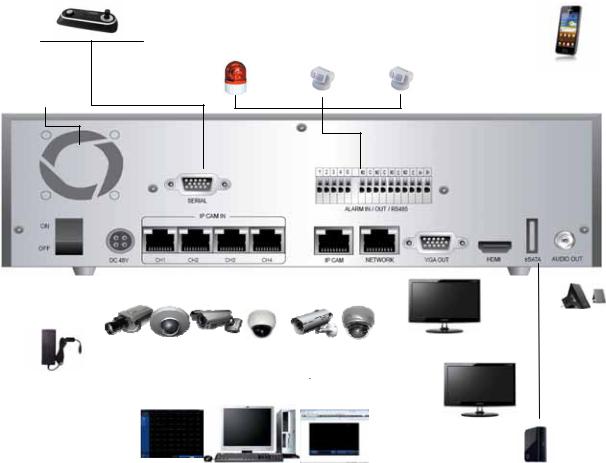
1.4. Basic Security System Configuration
Keyboard-Controller
Alarm Out |
Sensor Inputs |
NO Devices |
NC/NO Devices scalable |
DC 30V 1A max |
TTL Level Input |
AC 125V 0.5A max |
|
Smartphone
Fan
Power |
|
|
|
|
|
|
|
|
|
|
|
|
|
|
|
|
|
|
|
|
|
|
|
|
|
|
|
|
|
|
|
|
|
|
|
|
|
|
|
|
|
|
|
|
|
|
|
|
|
|
|
|
|
|
|
|
|
|
|
|
|
|
|
|
|
|
|
|
|
|
|
|
|
|
|
|
|
|
|
||||
|
|
|
|
|
|
|
|
|
|
|
|
|
|
|
|
|||||
Switch |
|
|
|
|
|
|
|
|
|
|
|
|
|
|
|
|
Amplified |
|||
|
|
|
|
|
|
|
|
|
|
|
|
|
|
|
|
|
|
|
||
|
|
|
|
|
|
|
|
|
|
|
|
|
|
|
|
|
|
|
||
|
|
|
|
|
|
|
|
|
|
|
|
|
|
|
|
VGA Monitor |
|
Speaker |
||
|
|
|
|
|
|
|
|
|
|
|
|
|
|
|
||||||
|
|
|
|
|
|
|
|
|
|
|
|
|
|
|
|
|
|
|||
|
|
|
|
|
|
|
|
|
|
|
|
|
|
|
||||||
|
|
|
|
|
|
|
|
|
|
|
|
|
|
|
|
|
||||
|
|
|
|
|
|
|
|
|
LOCAL |
|
|
|
|
|
|
|
|
|
||
|
|
|
|
|
|
|
|
|
|
|
|
|
|
|
|
|
||||
DC Power |
|
|
|
NETWORK OR |
|
|
|
|
|
|
|
|||||||||
|
|
|
|
|
|
|
|
|
|
|
||||||||||
Adapter |
|
|
|
INTERNET |
|
|
|
|
|
|
|
|||||||||
|
|
|
|
|
|
|
|
|
|
|
|
|
|
|
|
|
HDMI Monitor |
|||
|
|
|
|
|
|
Client Software |
|
|
|
Web Browser |
|
|
|
External HDD |
||||||
|
|
|
|
|
|
|
|
|
|
|
|
|
|
|||||||
WebViewer
11
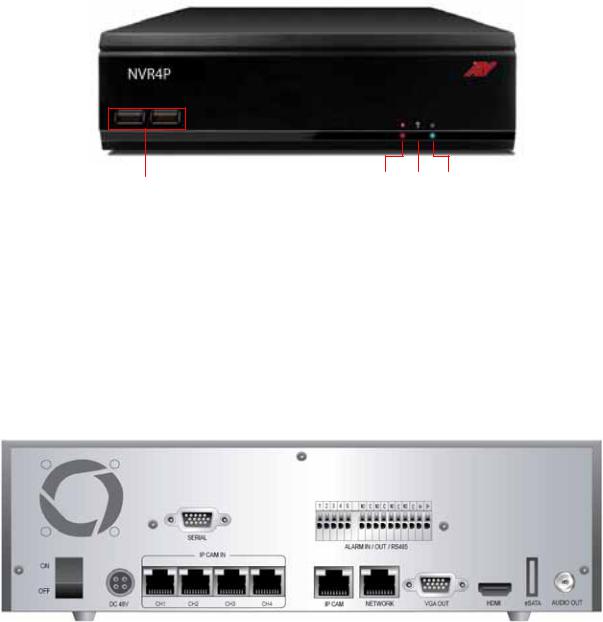
1.5. Front Panel View
1
○1 ○2 ○3 ○4
○1. USB 2.0 Port (x2): Connect USB mouse or USB memory device for file backup or firmware upgrade.
○2 REC LED: Recording indicator.
○3 IR REMOTE CONTROL SENSOR: Receives all incoming signals from the remote control ○4 POWER LED: DVR/NVR power indicator
1.6. Rear Panel View
12

1.7.IR Remote Control
1.Audio: ON/ OFF function.
2.REC (Record): Start/stop manual recording.
3.Number Buttons: Select camera (channel) number.
4.ID SEL: Allows you to select ID setting.
5.ID: Displays current ID.
6.Info: It will display system information.
7.Print: Allows you to Print image either in Live or Playback Mode.
8. Navigate Buttons: Left ▲ Up Right ▼ Down :
9.Enter  : To select and save the menu and parameter change.
: To select and save the menu and parameter change.
10.Menu: Enter or exit the menu.
11.Return: Directs you back to the previous menu. In Live Mode, this button will log you out.
12.Mode: Change the display mode to different split screen.
13.Freeze: Freezes images. (Only in Live Mode).
14.Zoom: Zoom in/out the video when the channel is single display mode.
15.Bookmark: It will list all the files that was bookmarked.
16.EZ Setup: You’ll be able to setup your system with simple pages.
17.K-Lock: Locks any keys from functioning.
18.Alarm: Turns the Alarm off.
19.Backup: Backups up desired data.
20.PTZ: Control PTZ camera(s) connected to your DVR/NVR.
21.Preset: A preset is a set of specific target points of a PTZ camera. 22.Tele: Zooms in on a specific area when using the PTZ function.
23.Wide: Zooms out of that specific area when using the PTZ function.
24.Search: Go to recorded file search menu.
25.Pause  : Pause a video during playback mode.
: Pause a video during playback mode.
26.Protect: You can protect recorded data from HDD overwriting.
27.Capture: You can capture video image either in Playback Mode or Live Mode.
28.REW: Rewind (select speeds from 2x4x8x16x32x64 for faster rewind).
29.Play: Play a recorded file.
30.■ Stop: Stop playback.
31.FF: Fast forward (select speeds from 2x4x8x16x32x64).
ID Setting Instruction:
1)Press down ID SEL button for 2 seconds to start the ID Setting Mode
2)Input any 2 digits to set ID.
3)Once the 2 digits are selected, press enter.
*If no action is taken within the 2 second allowed time period, it will automatically exit you from the ID Setting.
Installing batteries
1.Remove the battery cover by sliding in the direction of the arrow.
2.Insert two AAA batteries according to directions provided.
3.Replace the battery cover by sliding in the direction of the arrow.
13
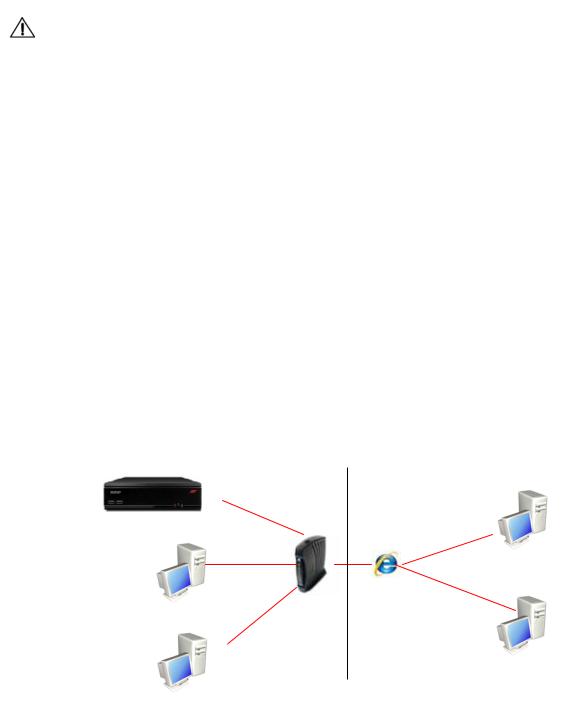
Chapter 2. Installation
2.1. HDD Installation
Before Installation
We recommend setting the current time on your NVR before HDD Installation. Please make sure that the power of NVR is switched off before starting installation.
Step 1. Make sure the NVR power is switched OFF
Step 2. Open the top cover of NVR using a cross screw driver.
Step 3. Take out the HDD mounting plate from NVR.
Step 4. Place HDD(s) on the mounting plate and mount it with screws.
Step 5. Replace the mounting plate into the NVR and fix it with screws.
Step 6. Attach the data and power cable to HDD(s) correctly.
Step 7. Replace the top cover of NVR and fix it with screws.
After HDD installation
Step 8. Turn the NVR power ON.
Step 9. NVR will detect HDD(s) during the booting and will format HDD(s).
Step 10. After HDD formatting, NVR will be automatically rebooted and will be ready to work with HDD(s).
2.2. Network Connection Setup
2.2.1. Using a Static IP Address
You can use the Static IP address, Subnet Mask and Gateway address provided by your ISP (Internet Service Provider) for your NVR. The Gateway address is the IP address of your broadband modem.
Internet
14

2.2.2. Using a Dynamic IP Address
You can use a router with your Dynamic IP broadband modem. In this case, you should set the configuration of a router properly for network connection between NVR and Net/Web Viewer. Please follow the instructions in next section to configure your router correctly.
Home/Office Network |
|
Internet |
||
|
|
|
|
|
If your Broadband Modem does not support internal loop back (port forwarding) function and you want to monitor NVR using a PC located in same Intranet, you should use Direct IP instead of DVRNS in the connection menu of NetViewer. If your PC is located outside of Intranet, you can use both DVRNS and Direct IP to connect to NVR even though your Broadband Modem has
limited features.
2.2.3. Router Configuration
If your NVR is connected to the network through a router, you should configure router properly. There are 3 steps as follows.
1. WAN Setting 2. DHCP Setting 3. Virtual Server Setting
2.2.3.1. WAN Setting
When you connect to your Router, you can find menu for WAN setting. Please confirm the WAN setting. If you are using DSL service, you should select PPPoE, and you will be directed to a sub-menu to type in DSL user name and password.
15
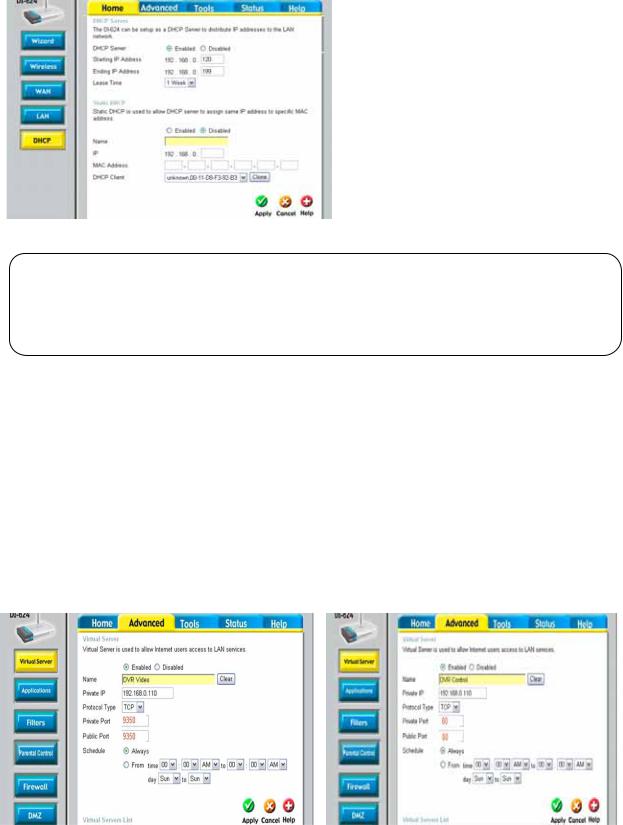
2.2.3.2. DHCP & IP Address Setting
To assign a unique private IP address to NVR in your intranet environment automatically, you can enable DHCP option in the Network Setup menu of your NVR and your Router. In this case, you can skip the procedures described on this page.
We recommend assigning IP address to NVR manually to prevent unexpected change of IP address.
*A router from D-Link is quoted as an example in this manual. The images of setup menu above may not always match another router’s setup menu.
If you have any problem with DHCP function or want to assign the private IP address, please disable DHCP option in the Network Setup menu of your NVR and check the starting and ending IP used by DHCP server of the Router. You can assign any private IP address to your NVR even if it is out of the DHCP range, but the IP address should match with the one entered in the Network Setup menu of your NVR.
2.2.3.3. Virtual Server Setting
You should register your NVR as a virtual server. Please enter the information into IP address field of the router (e.g. 192.168.0.110).
Protocol Type should be TCP. Private/Public Port numbers should be the same with the Port numbers assigned in NVR. You can change port numbers in Network Setup menu to avoid conflict with other network servers.
Your NVR uses 3 port numbers and the default Port numbers are 9350~1 and 80. 9350~1 are for controlling the video, audio and commands of Net Viewer, and 80 is for Web Viewer. You need to register 3 port numbers into the router as network servers. Please make sure that your router does not block those port numbers to/from the NVR with filter and firewall features.
The image is only for your reference. Depending on the Router manufacturer, the setting can vary.
16
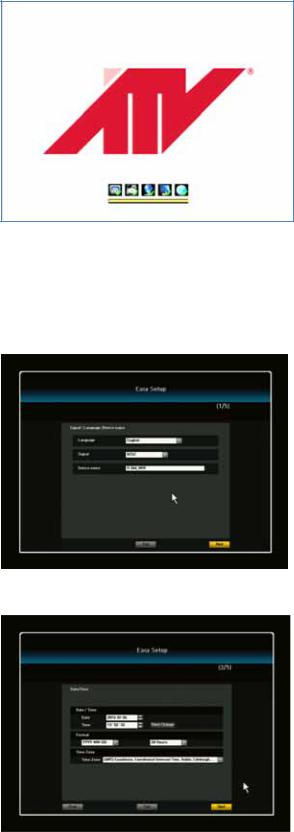
STARTING THE SYSTEM
When power is turned on, you will see the initializing screen and it may take up to one minute to complete. After initializing is complete, an Easy Setup screen will appear.
EASY SETUP
An Easy Setup screen of 5 steps will appear. If you don’t like to setup all at this point and like to skip the steps, please click the Exit button. Then the system will exit to main live screen. However, you can setup the system at anytime you want by click the Easy Setup Menu or Main Menu.
[1/5] Signal / Language / Device Name
The user can set the OSD language, signal and device name.
[2/5] Date/Time Setup
In this step, the user can set the date and time of the system, and Time zone as well.
17

[3/5] Connection Mode setup
The user can set the Network and IP camera connection mode properly according to the network connection.
** For detailed information, please refer to the 3.5. Network Setup page of this manual
[4/5] IP Camera Registration
The user can check the IP camera listing and register the desired IP cameras automatically or manually by click the Auto/Manual button.
Quick search: the user can search the IP cameras connected to the network and system quickly. In this case, the user must enter the camera ID and Password one by one.
Detail search: if the user selects the Detail search, it will take more time to search all the cameras comparing to quick search. The system checks all IP camera IDs and Passwords automatically. The user needs not to enter the IP camera ID and password separately. The registered camera can be detected automatically from the NVR, so the user needs not to enter the ID and PW of IP camera separately.
Manual add: if the user wants to add the remote cameras manually, firstly the user check the IP camera address to register to the system. The IP camera must support Onvif and enter the full Onvif IP camera address. Ex. http://192.168.10.110/onvif/device_service.
* For detailed information, please refer to the IP camera registration page of this manual
18

[5/5] Schedule recording
The user can set the schedule recording as continuous, event and both (continuous and event) by drag the desired date and time.
After Easy Setup is completed or exited from Easy Setup menu, a live screen will appear.
When the user does not log-in the system and click to any menu, it will prompt you to the login dialog. Enter ID and Password by using the virtual keyboard and click OK. By default, the ID is set at “admin” and the Password is set at “admin”
19
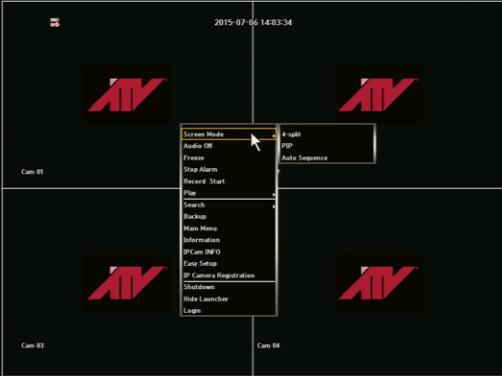
Live Menu Description
1 |
Screen Mode |
Can select how you would like to view screen |
|
|
|
2 |
PTZ control |
Can activate PTZ window to control the PTZ function. |
|
|
|
3 |
Zoom In |
Can zoom in for the desired area. |
|
|
|
4 |
Audio On/Off |
Option to have the audio on or off |
5 |
Freeze |
Can freeze Playback or Live scene |
6 |
Stop Alarm |
Stops the alarm output and the event monitoring. |
|
|
|
7 |
Record Start/Stop |
Starts/stops the manual recording |
|
|
|
8 |
Play |
Plays the search result (for 30sec. 1min, 5min, 10min and all) |
|
|
|
9 |
Search |
Can search for recorded data (by time, event, capture, etc) |
10 |
Backup |
Can backup data via USB drive |
11 |
Main Menu |
Access the main menu. |
|
|
|
12 |
Information |
This menu will display system information |
|
|
|
13 |
IP Cam INFO |
It will display you IP camera information |
|
|
|
14 |
Easy Setup |
You’ll be able to setup your system with simple. |
15 |
IP Camera Registration |
You can search the registered cameras and add the cameras. |
16 |
Shutdown |
Will allow you to completely shut down the unit |
|
|
|
17 |
Hide Launcher |
Hides the launcher. |
|
|
|
18 |
Logout |
You can log out. |
|
|
|
|
|
20 |

System Information
When the user clicks the right click menu on the live screen and select Information menu, the system information will appear with overall system info.
When there’s an exclamation , this indicates that the NVR has not been registered in our DVRNS server
, this indicates that the NVR has not been registered in our DVRNS server
Password will only show half of the registered password. You can enter up to 8 characters max. If four characters are used in the password, it will show as 12**, six characters will
show as 123*** and eight character, 1234****
Network Map: By clicking the Network Map button, it will display a page with all your IP camera status. If the IP camera is connected, then a blue line will be shown. If the camera is disconnected, then a blue line with a red X mark will be shown. If there is a connection error, a solid red line will be shown.
By using you mouse, you can navigate to each IP camera to see the camera information.
21
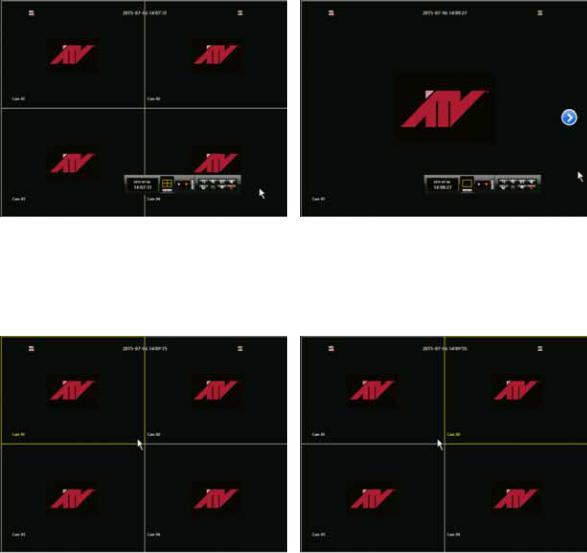
Live Menu navigating using the mouse
Navigating to the different channels by using the mouse.
By using the mouse, move the mouse to the far right in the middle of the screen and an arrow button will appear on the screen to navigate to different channels. You can only navigate from one channel to another when viewing in a single screen/channel. If you are viewing from a 4-split screen, you will NOT be able to navigate using the arrow. This feature will only work when viewing from a single screen
When viewing from a 4-split screen, you can use your mouse to navigate from channels to channels. When a channel is selected, a yellow border will show indicating the channel selected. By using your mouse, you may go to desired channel.
22
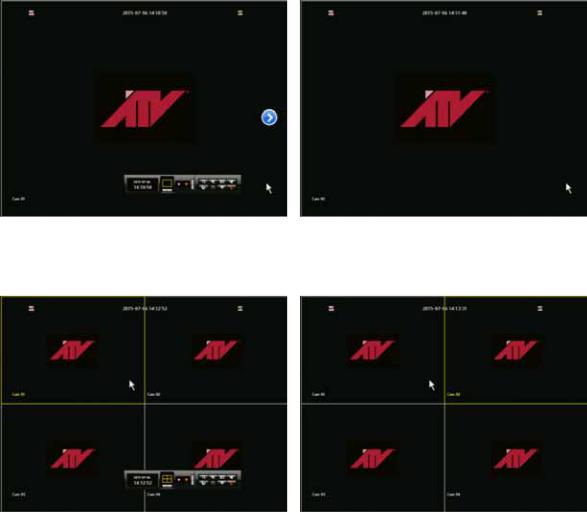
Navigating to different channels by using the remote control.
To navigate from one channel to another channel, you must first select the channel and it must be on a single full screen view. By pressing the direction button on the remote control , it will take you to the next channel in sequential order.
If a channel is selected (has yellow border), you can use the remote control by using the arrow buttons to navigate to individual channels. To select a channel using the remote control, press the enter button
 and a yellow border will appear on that channel, (see above picture). After the channel has been selected and by using the arrow buttons on the remote control, you can navigate to desired channels.
and a yellow border will appear on that channel, (see above picture). After the channel has been selected and by using the arrow buttons on the remote control, you can navigate to desired channels.
23

Chapter 3. Main Menu Setup
• Go to Main Menu Window using:
Remote control – Press MENU,
Mouse – Right click and click Main MENU.
•To go to desired sub menu:
Use direction keys and press ENTER (remote control) or click on sub menu with the mouse.
•To go to the higher level menu:
Remote control – Press MENU,
Mouse – click the desired higher menu or OK / Cancel button
Main Menu Tree
|
|
VIDEO/AUDIO |
|
RECORD |
|
DEVICE |
|
|
Camera |
Policy |
Storage |
||
|
|
|
|
|
|
|
|
|
IP Camera Registration |
|
Record Quality |
Sensor / Video Loss Detection |
|
|
|
|
|
|
||
|
|
IP Camera Setup |
Record Method |
Alarm Schedule |
||
|
|
|
|
|
|
|
|
|
Image Setup |
|
Record Option |
PTZ |
|
|
|
|
|
|
||
|
|
Monitor |
Schedule |
System controller / Printer Device |
||
|
|
|
|
|
||
|
|
Sequence / Event Display |
Holiday |
Video Analysis |
||
|
|
|
|
|
|
|
|
|
OSD / Display Position |
|
Motion |
|
|
|
|
|
|
|
|
|
|
|
Screen Mode |
Event Record Duration |
|
|
|
|
|
SYSTEM |
|
NETWORK |
|
BACKUP |
|
|
Date/Time |
|
Connection |
|
Backup |
|
|
|
|
|||
|
|
|
|
|
|
|
|
|
Signal / Language / Device Name |
Port / Connection Test |
|
|
|
|
|
|
|
|
|
|
|
|
Config |
|
DVRNS/Dashboard |
|
|
|
|
|
|
|
|
|
|
|
Log Information |
|
DDNS |
|
|
|
|
|
|
|
|
|
|
|
Admin |
|
FTP File Transfer |
|
|
|
|
|
|
|
|
|
|
|
Group |
Email / SNS |
|
|
|
|
|
|
|
|
|
|
|
|
User |
iSCSI |
|
|
|
|
|
|
|
|
|
|
|
|
Setup |
|
|
|
|
|
|
|
|
|
|
|
24
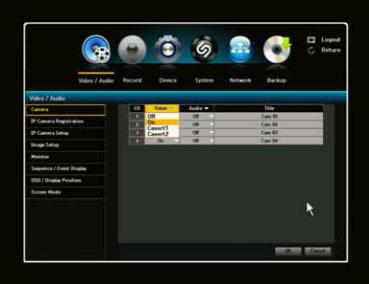
3.1. Video/Audio Setup
There are 5 sub menus under Video/Audio. To exit to main menu, press MENU key again (or right click on the mouse).
3.1.1. Camera
In the Camera menu, you will be able to set up your camera to a desired setting. Click the Camera menu and it will route you to a Camera setup page.
1)VIDEO: You may select the video ON, OFF, COVERT 1 or COVERT 2. ON: Pictures/Images and icons will appear on screen as normal.
OFF: When the video is switched to OFF, there is no action taken, (no images / pictures, recordings icon, etc.) but only camera title will be displayed on the screen.
COVERT 1: Video/pictures will not appear and will be blank/black, but icons and camera title will appear. Despite being in covert, the NVR will continue to record.
COVERT 2: In this mode, the screen will be completely blank including icon, camera names, etc. but will continue to record.
2)AUDIO: You may select the audio ON or OFF position. If you want to activate the Audio function, firstly you should select Audio On for the desired cameras in the Camera Menu and then go to IP Camera Setup menu to set the Audio section of the camera as G.711 position.
3)TITLE: Create your own title for each camera connected to the NVR by using the virtual keyboard (up to 15 characters). If you skip this setup, camera # will be displayed on the screen.
25

3.1.2. IP Camera Registration
For desired IP camera use, you must first register the IP cameras in the IP Camera Registration menu. ** For ATV IP cameras, you do not need to register. It will automatically register. For Samsung, Axis and other brand IP cameras, you must perform these two tasks, time sync and then register.
In the IP Camera Registration menu, a list of IP cameras will appear that have been detected automatically. This will be your default setting. If you wish to manually add the IP cameras, click the Auto/Manual button. For the details, please refer to the descriptions of “Auto/Manual” setting below.
Camera search:
-Quick search: the user can quickly search the IP cameras connected to the NVR. In this case, the user should enter each ID and Password for connecting camera. Check the “Quick” box to click the “Search” button.
-Detail search: if the user selects the Detail search, it will take more search time comparing to quick search, however the system checks all IP camera’s ID and Password automatically, and the user need not to enter the IP camera ID and password separately. Check the “Detail” box to click the “Search” button.
26
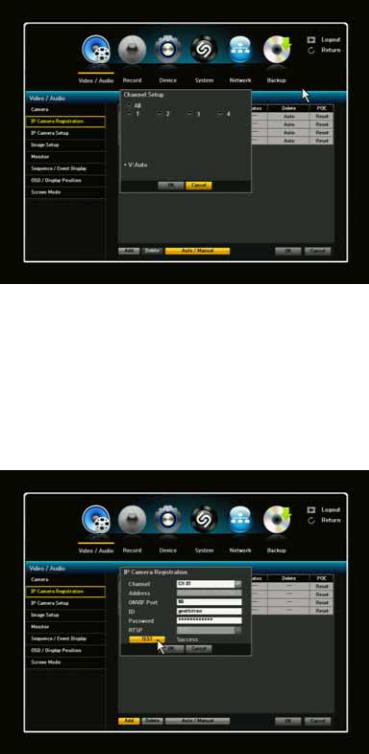
Auto/Manual: By clicking this button, you will be able to select which channel(s) to register automatically. If unselected/un-checked (mark V), then that channel will not register automatically. You can select all channels or specific channel(s).
**Only IP cameras that support Zero Config. will be able to connect automatically.
Once you have clicked the ADD button to click the “Search” button, a list of IP cameras will appear on the screen that has been detected automatically. To select the desired IP camera, simply click the “Registration” tab.
And then IP Camera Registration window will appear. Enter the camera ID and PW to click the TEST button to see if the connection is successful. If all the information is correct, you will see “SUCCESS” indicating that the camera is ready for operation. If the connection has failed, double check the information entered. Once everything is successful, then click the OK button.
When Search button is clicked, it will search all the registered IP cameras again. If you would like to add remote site IP camera, click the “Manual Add” tab.
A window will appear to enter IP camera information. Enter the camera Address, ID and PW to click the TEST button to see if the connection is successful. If it’s successful, click the OK button.
27
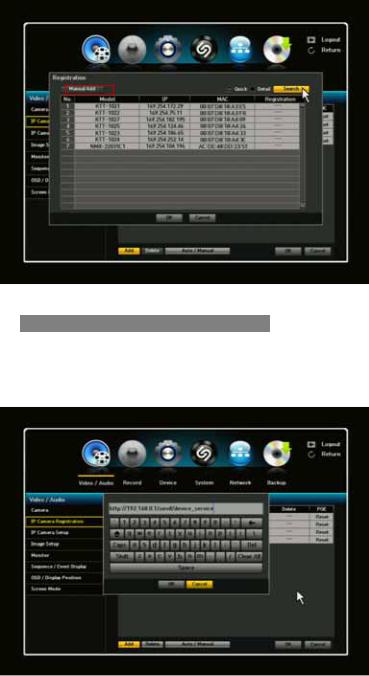
For the camera Address should be as:
Ex)http://192.168.10.110/onvif/device_service. The colored part should be entered with the correct IP camera Address. In this case, the IP camera must support Onvif.
By clicking the IP tab, you will be able to edit your IP camera registration. Once you have made the changes, click the TEST button to see if it was successful.
When all IP cameras are registered and ready for use, you can always go back and delete the cameras.
Simply by clicking the delete button, a window will appear in the middle of the page asking if you would like to delete. Click OK to delete the specific camera channel or all.
28

PoE Reset: will power ON/OFF of the camera automatically. When a RESET tab is clicked, a popup window will appear to confirm your selection and then proceed.
3.1.3. IP Camera Setup
In this menu, you will be able to setup your IP camera to desired setting. By clicking the IP Camera Setup tab, you will have five (5) different settings to work with.
-Profile, Resolution, FPS, Quality and GOP (Group of Pictures)
Click on the desired channel and then IP camera setup page will appear.
Profile: We recommend “Main” profile because it allows the most efficient coding of video. It reduces the required network bandwidth for video. The only profiles that can be enabled are ones supported by the camera. If you cannot enable it, then the camera does not support that particular profile.
Capture: It will display capture resolution supported by the camera. Once the Capture tab is clicked, a window will appear to set.
Resolution: It will display resolution options supported by the camera. Once the Resolution tab is clicked, a window will appear in the middle of the page. Scroll down on the Resolution bar and select desired resolution setting.
29
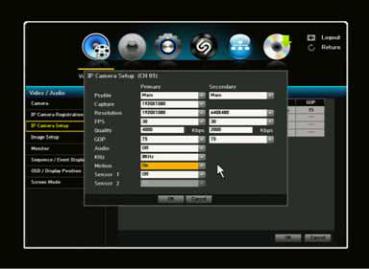
FPS: To select desired FPS, click on the FPS bar and scroll down. Maximum FPS allowed is 30. The NVR does not support FPS 60.
Quality: For desired quality setting, click on the bar next to Quality. Once the bar has been clicked, a virtual keyboard will appear in the middle of the screen.
By using the keyboard, enter the desired quality setting. Keep in mind that maximum Kbps is 6000.
GOP: Once you have clicked the GOP tab, click the GOP bar and scroll down to desired GOP setting. Keep in mind the maximum GOP is 30 and the recommendation GOP size is a half of FPS. (Example; if the FPS is 30, then the GOP of 15 is recommended)
Audio: Only support G.711. If the IP camera does not support G.711, then it will display as OFF.
KHz: Only support 8KHz (this is audio sampling rate). If the IP camera does not support 8KHz, then it will display as OFF.
Motion: Default is OFF. If you select ON, it will allow the NVR to receive motion events from the IP camera. Also, when it’s in ON position, the NVR will allow the user to use event recording.
**If you would like to use MOTION recording, you MUST have the EVENT in ON position at all times. The NVR will automatically set the motion area(whole screen), but if the user wants to set their own motion area, they can set the motion area of individual channel from Motion option of Record menu. Please refer to 3.2.7 Motion.
Sensor: Default is OFF. If you select ON, it will allow the NVR to receive sensor events from the IP camera. There are 2 different types of sensor positions: (N.O = NORMAL OPEN and N.C. = NORMAL CLOSE). Depending on the IP camera, Sensor 1 and Sensor 2 can be enabled if the IP camera can support two sensors.
Secondary: The purpose of secondary is to send low bandwidth stream to remote client software such as smartphone, tablet, etc. It will also display in real-time to multi view mode. You can also setup different settings in secondary such as:
-Profile: Select a profile that’s desired. Main is recommended.
-Resolution: Max resolution is 704 x 480 depending on IP camera’s resolution support.
-FPS: Maximum FPS is 30.
-Quality: By using the keyboard, enter the desired quality setting. Keep in mind that maximum Kbps is 6000.
-GOP: Maximum GOP is 30 and a half of FPS is recommended as a GOP size.
30
